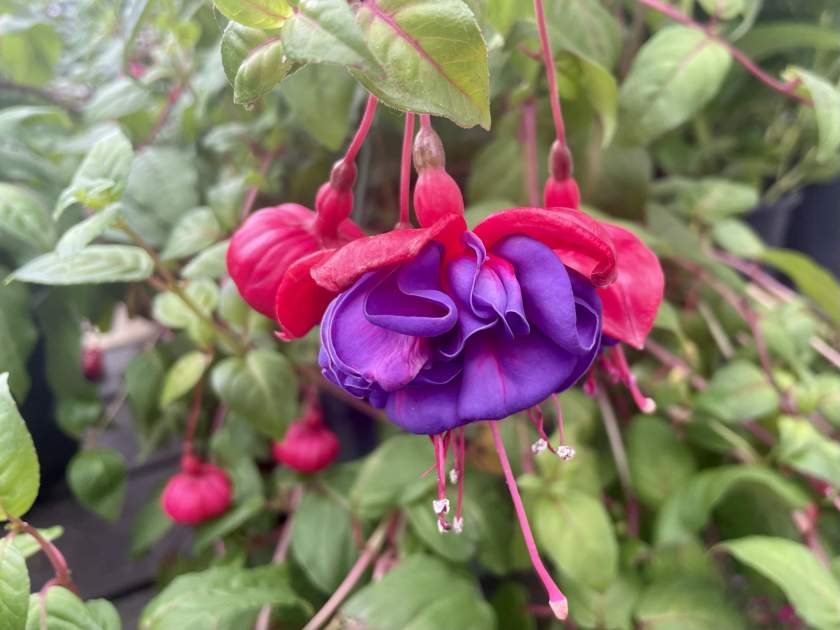Fuchsia ‘Dark Eyes’ is a hybrid fuchsia that was first introduced in 1986. It is a deciduous shrub that typically reaches a height and width of about 45-60 centimeters (18-24 inches). This fuchsia cultivar features dark green, oval-shaped leaves. The flowers of Fuchsia ‘Dark Eyes’ are medium-sized and double, with red sepals and a striking violet-blue corolla. They bloom from early summer until the onset of frost, providing a vibrant display of color. The plant is highly valued for its ornamental qualities and is commonly used in gardens, containers, and cut flower arrangements.
Fuchsia ‘Dark Eyes’ belongs to the family Onagraceae, also known as the Willowherb Family or Evening Primrose Family. The Onagraceae family includes a diverse range of flowering plants, and fuchsias are one of its well-known members. Fuchsias are admired for their pendulous flowers, rich color variations, and attractive foliage.
How to grow Fuchsia ‘Dark Eyes’:
To successfully grow Fuchsia ‘Dark Eyes’, it is important to provide the right growing conditions. This cultivar thrives in full to partial shade, although it can tolerate more sunlight if the temperatures are mild. It prefers moist, fertile, and well-drained soil. Regular watering is crucial, especially during hot weather, to prevent the soil from drying out. It is recommended to fertilize the plant every two weeks during the growing season to support its growth and blooming.
Caring for Fuchsia ‘Dark Eyes’ is relatively straightforward. However, it is important to be vigilant for common pests such as spider mites, which can affect fuchsias. Regularly inspect the plant for any signs of infestation and take appropriate measures to control pests if necessary. Pruning the plant in the spring, before new growth begins, helps maintain its shape and encourages fresh growth for the upcoming season.
Additional tips for caring for Fuchsia ‘Dark Eyes’ include protecting the plant from cold winds and frost. If you live in a cold climate, consider bringing the plant indoors or providing appropriate winter protection to ensure its survival. Avoid overwatering the plant, as excessive moisture can lead to root rot. With proper care and maintenance, Fuchsia ‘Dark Eyes’ will reward you with its stunning flowers and contribute to the beauty of your garden or container displays.
Fuchsia ‘Dark Eyes’ is a stunning and popular cultivar of the fuchsia plant, known for its striking appearance and eye-catching flowers. Cultivating Fuchsia ‘Dark Eyes’ can be a rewarding experience, but it requires some specific care and attention to ensure its optimal growth and bloom. Here’s a guide to help you successfully cultivate this beautiful fuchsia cultivar:
Cultivation :
Selecting the Right Location: Fuchsia ‘Dark Eyes’ thrives in a location with bright, indirect light. It prefers a spot with partial shade, especially during the hottest part of the day. Avoid placing it in full sun, as excessive heat can scorch the delicate leaves and flowers.
Soil and Pot Selection: Fuchsia plants prefer well-draining soil that is rich in organic matter. A mixture of peat moss, perlite, and compost will provide a suitable growing medium. If you’re planting in a pot, ensure it has drainage holes to prevent waterlogged roots.
Watering: Keeping the soil consistently moist is crucial for fuchsia plants. They don’t tolerate drying out, but they also dislike standing in water. Water the plant thoroughly whenever the top inch of soil feels dry to the touch. During hot weather, you might need to water more frequently.
Fertilization: Fuchsia ‘Dark Eyes’ benefits from regular feeding during the growing season, which is typically spring to early fall. Use a balanced, water-soluble fertilizer or one specifically formulated for fuchsia plants. Follow the manufacturer’s instructions for the appropriate dosage.
Pruning: Pruning is essential to maintain a bushy and compact shape for your fuchsia plant. Pinch off the tips of the branches when the plant is young to encourage branching. Deadheading spent flowers will also promote continuous blooming.
Support: Fuchsia ‘Dark Eyes’ can become a bit leggy, especially when grown in containers. Providing support, such as a small trellis or stake, can help the plant maintain an upright and graceful appearance.
Pest and Disease Control: Keep an eye out for common pests like aphids, whiteflies, and spider mites. Regularly inspect the plant for any signs of infestation and treat the issue promptly with insecticidal soap or neem oil. Proper air circulation and avoiding water on the foliage can help prevent diseases like powdery mildew.
Overwintering: Fuchsia ‘Dark Eyes’ is typically not cold-hardy and may not survive frost or freezing temperatures. In colder climates, consider bringing the plant indoors during the winter months or providing it with protective coverings.
Propagation:
You can propagate Fuchsia ‘Dark Eyes’ through cuttings. Take 4-6 inch long stem cuttings from a healthy and established plant during the growing season. Remove the lower leaves and dip the cut end in a rooting hormone before planting it in a well-draining rooting medium.
Enjoy the Flowers: Fuchsia ‘Dark Eyes’ produces stunning pendant flowers with dark purple petals and contrasting pink sepals. The blossoms are a favorite of hummingbirds, adding an additional charm to your garden or patio.
Remember that each plant can have its unique needs, so observe your Fuchsia ‘Dark Eyes’ closely and adjust your care routine accordingly. With the right attention and care, you’ll be rewarded with an abundance of beautiful blooms from this captivating fuchsia cultivar.
By following these guidelines, you can enjoy the beauty of Fuchsia ‘Dark Eyes’ and enhance your outdoor or indoor spaces with its vibrant presence.




